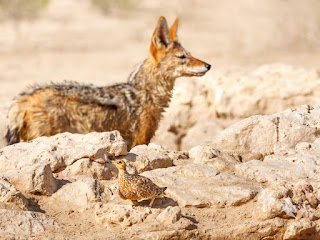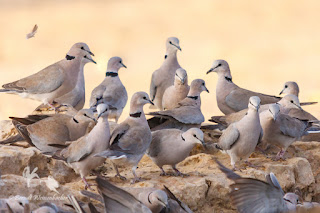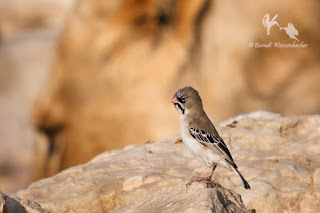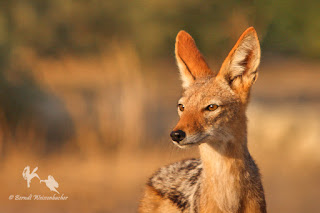I have a vivid memory from my boyhood days of catching sight in a photography magazine of a dramatic image of a Black-backed Jackal hunting Cape Turtle-Doves at one of the many water holes along the Auob River in the then Kalahari Gemsbok National Park (now the Kgalagadi Transfrontier National Park) in the Northern Cape Province of South Africa. The photograph left an indelible impression on me at the time. The jackal was shown in full flight, jaws wide open, about to snap shut on a turtledove, one of many that had exploded upwards from the waterhole. The drama was captured at just the right moment; no contact had yet been made between hunter and prey, yet the image left no doubt about the inevitable outcome – the turtledove would be snatched despite its frenzied breakaway and the jackal would have its meal.
Sadly, I can not recall the photographer who portrayed this drama (and I apologise for this lapse of memory). Since this iconic instant was captured on slide film (in good light, with appropriate exposure and exceptional composition and drama), countless photographers repeatedly have attempted to recreate this singular image – none has succeeded to get it just right. Inevitably, the numerous published attempts have depreciated some of the uniqueness of the original photograph, yet it remains outstanding and unequalled to this day.
Once glimpsed, many exceptional images are stored away safely in a corner of my mind. I reimagine them repeatedly for their sheer brilliance of circumstance, camera technique and photographic vision. These outstanding achievements act as a constant reminder to myself to up my own game, to refocus and to re-sharpen my own interpretation of selected scenarios in nature and to hone my own personal vision in photography.
Several years ago, I had the good fortune to spend almost two weeks in the Kgalagadi Transfrontier National Park. I avoid copying an image of another photographer at all cost; however, I too felt the need to capture some of the relationship between the Black-backed Jackal and the Cape Turtle-Doves of the Kgalagadi. Despite my relatively short stay at Nossob Camp, I decided to dedicate two full mornings of photography to my own attempt at a different interpretation of the relationship between these hunters and their prey.
On two mornings of the trip, I took up position at a waterhole that I had selected for this task. Other than focussing on my previsualised mini-project, I remained receptive to all of the many interactions happening at this one locality. On both mornings, the low thorn-trees surrounding the waterhole were chockfull with feathered folk. Hundreds of doves descended from the trees onto the rocky rim of the waterhole once a small number of them had scraped up sufficient courage to do so. After settling on the ground, it took only a few jittery individuals, taking off in panic, to trigger a swirl of doves to ascend back into the air, to flail around the waterhole in wide circles and finally to settle down again on the thorn-trees.
Each morning, several individual jackals kept trotting in to the waterhole to quench their morning thirst. A few times, individuals snapped at turtledoves, but only half-heartedly – no jackals showed any determined attempt to start hunting doves. Nevertheless, the time I spent at the waterhole proved fruitful – I managed to capture doves in flight, several other small seedeaters, several portraits of jackals and even lions coming for a drink.
It had never been my intention to copy the image of the jackal hunt of turtledoves that I can recall so clearly from boyhood. I needed to attempt my own photographic summary of this interrelationship between hunter and the hunted. The first morning allowed me to observe the dynamics of the Cape Turtle-Doves and the Black-backed Jackal – how both species acted while on their own and when in the presence of the other. The first morning thus produced images of the Cape Turtle-Doves and the Black-backed Jackal separately – in particular, the difference in appearance and behaviour of individual jackals fascinated me, as did the haphazard explosion of doves from the rim of the waterhole.
By the second morning, I felt confident that I could capture the relationship between the hunter and its prey. I had seen that the turtledoves would lift off en masse whenever a jackal approached the waterhole. I knew that I would not witness a hunt; yet, I had previsualised a scenario where I could possibly snap the portrait of a jackal surrounded by flying doves. With this in mind, I concentrated exclusively on the shenanigans of the turtledoves and the jackals.
After several hours of waiting, a youngish jackal approached the waterhole warily – every time any doves flew up, the jackal would stop. This ideal scenario would allow me to capture my imagined image. I focused continuously on the head of the young jackal and clicked the shutter whenever several turtledoves appeared in the viewfinder around the jackal’s head. In total I took seven exposures – four turned out to be duds because the jackal’s face and eyes were concealed by part of a wing or a body of a dove. Of the remaining three images two had worked really well, but one image, in particular, summarised as closely as possible the image I had dreamt up in my imagination – the much gentler, less tense relationship between ‘The Hunter and the Hunted’.
I did not return to this particular waterhole for the remainder of my stay at Nossob Camp. Instead, I roamed around to capture, whenever possible, other fascinating, awesome and beautiful images of the Kgalagadi.







No comments:
Post a Comment